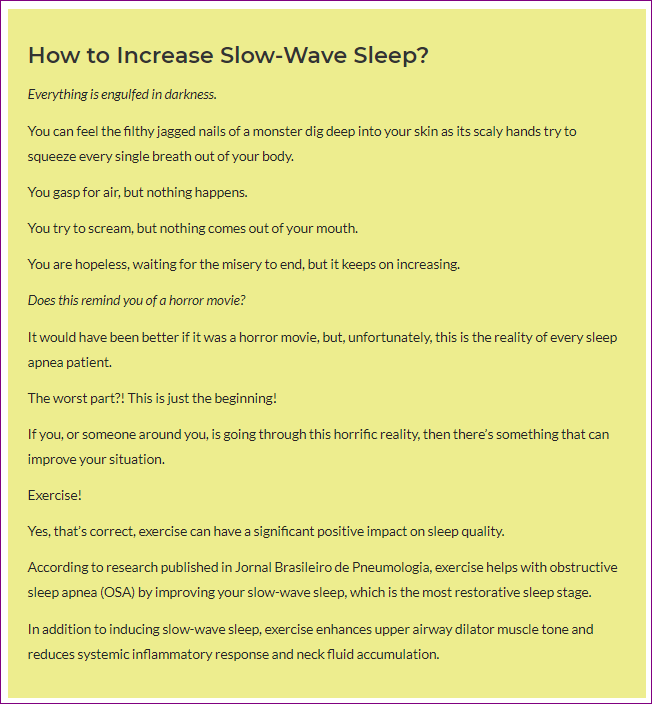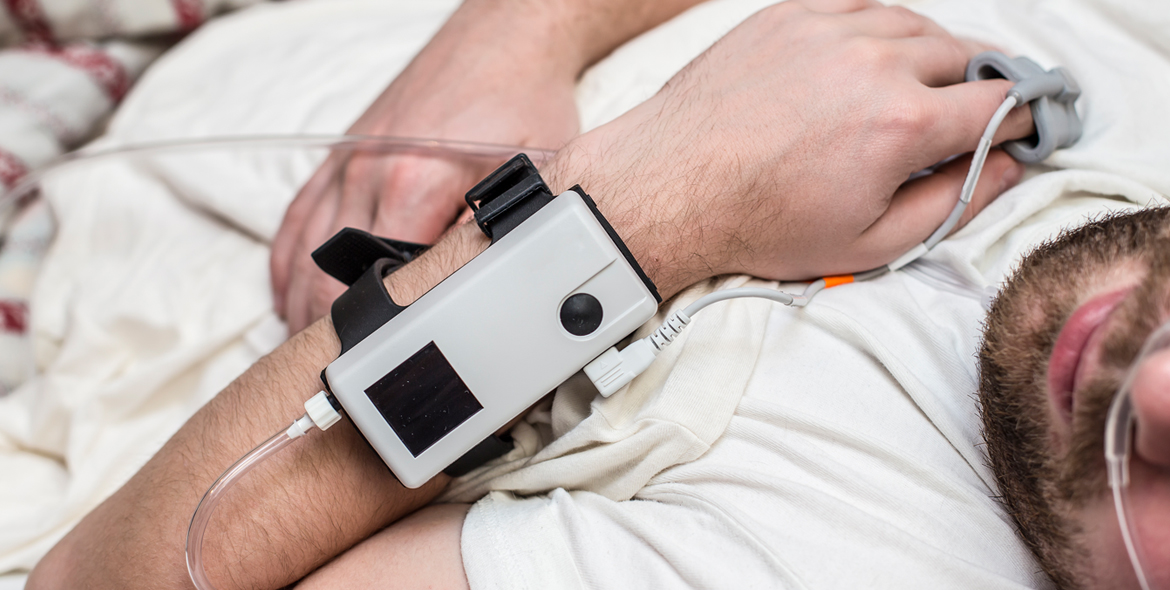9 Tips And Exercises To Ease Sleep Apnea
- Anthony Andrews
- March 17, 2021
- Meditation / Yoga Wellness
What Exercises Aid In Alleviating Sleep Apnea?
1. Does Exercise Help With Sleep Apnea?
Obesity is the most common cause of Obstructive Sleep Apnea Syndrome (OSAS) in adults.
According to research, regular exercise causes weight loss, particularly around the neck region.
As a result, the study found a 26% decrease in the apnea-hypopnea index (AHI) and relief of sleep apnea symptoms.
Maintaining a healthy lifestyle can help in eliminating sleep apnea condition.
To do so, you must first begin to lose weight by eating a healthy diet and engaging in exercise.
Aerobic exercise, resistance training, brisk walk or regular 30-minute walk, yoga and some cardio-workouts are few of the recommended regular exercises you can try.
It does not only help you get in shape and free from cardiovascular issue, but it is also one of the most effective ways to reduce the severity of sleep apnea, daytime sleepiness, and efficiency in getting quality sleep.
Aside from that, there are some techniques you can try, such as mouth and throat exercises, oropharyngeal exercises and breathing exercises, which will be discussed further below.
2. What Is The Role Of Myofunctional Therapy in Sleep Apnea?
Myofunctional therapy exercises or “oropharyngeal exercises” entails exercises that focus on the facial muscles intending to increase airflow, particularly at night.
It improves breathing problems and is commonly used by dentists or orthodontists to treat people who have a bite problem, abnormal lip, jaw, and tongue position, and is also used to correct facial posture.
Myofunctional therapy should be performed at least four times per day with the assistance of a trained Myofunctional therapist.
Examples of sleep apnea exercises classified in myofunctional therapy are:
Playing musical instruments that require the use of facial muscles. Examples of such instruments are clarinets, trumpets, and flutes.
Singing or warming up your voice or vocalization. Sing your favorite tune at the top of your voice. It helps tone the muscles involved in articulation and improves lung capacity, and enhances the diaphragm tone. You can also try yawn-sigh technique, jaw loosening exercise or lip buzz vocal warm-up exercise repeatedly.
The cheek hook exercise. It involves placing your finger lightly on the inner side of your cheek and pressing the cheek outwardly. Using your facial muscles, try to counteract the motion of the finger. Repeat the technique at least five times a day on either side of the cheeks for three months
Facial Exercise. Purse your lips to tightly close your mouth. While keeping your jaw and lips relaxed, open your mouth. Repeat continuously.
English Vowel Sound Pronunciation. This exercise is most common for kids and adults with soft palate. Normally, patients pronounce oral vowel sounds continuously or intermittently.
Current research illustrates that myofunctional therapy reduces the AHI by 50% in adults older than 50 years old and 62% in kids.
This exercise has also proven that doing this more often will help reduce snoring and help patients with moderate OSAS.
Therefore, more physicians are embracing Myofunctional treatment as an adjunct therapy in OSAS.
For a more visual representation of the exercises, consider looking at the following videos:

3. How do you stop your tongue from blocking airways?
Tongue exercises are one of the techniques in treating sleep apnea.
This exercise is also good for people suffering from TMJ (temporomandibular joint). It can also help improve your swallowing issues.
Before you start doing below sample exercise, make sure to remove other distractions to allow you to focus:
The tongue slide exercise. The exercise entails by placing your tongue on the soft palate located on the mouth's roof and gently gliding your tongue in a downward motion towards the throat. Repeat 5-10 times.
Tongue Stretch Exercise. Place your tongue on the roof of your mouth, and then slowly open your mouth. Or stuck out your tongue and try to reach your chin as far as you can. You should feel the stretch of your tongue by holding it for 10-15 secs, repeat 5 times.
Tongue Push Up. Keep a good posture then push your tongue on the roof of your mouth and gently push your tongue upward. Keep it close open for 5-10 seconds.
Such exercises aim at enhancing the tongue muscle strength and tone.
4. Can Throat Exercises Relieve Sleep Apnea?
Throat exercises, just like tongue exercises, are useful in alleviating sleep apnea symptoms.
It incorporates both tongue and articulation exercises.
Experts recommend pronunciation of the vowels at least ten times each day for a minimum period of three months.
5. Which sleeping position is best for sleep apnea?
Lying on your back is harmful in patients suffering from sleep apnea.
The latter precipitates the rolling of the tongue to the airway opening, which obstructs and exacerbates sleep apnea.
The dangers of lousy head postures during sleeping is mitigated by limiting the range of head movement and the sleeping angle.
Experts recommend placing a wedge-shaped pillow to elevate the head’s position relative to the rest of the body.
Alternatively, you can use a recliner bed to achieve a more upright posture while sleeping.
6. What's The Relationship Between Alcohol, Smoking, Sedatives, and OSAS?
Alcohol and sedatives induce muscle relaxation in the throat, which worsens sleep apnea.
While some believe that alcohol is effective in inducing sleep, however in the long-term drinking alcohol or smoking nicotine especially before bed can cause an even more disruptive sleep.
According to studies, smoking has also been identified as a risk factor for developing OSAS.
As a result, medical experts advise avoiding alcohol, sedatives, and nicotine use among patients with obstructive sleep apnea syndrome.
Furthermore, alcohol consumption disrupts the REM cycle, leaving anyone sleep-deprived.
Also, excessive use of alcohol combined with smoking can result to cardiovascular disease, ischemic stroke, myocardial infarction, bladder cancer, stomach cancer and other diseases.
Consider limiting the amount of alcohol consumed and quitting smoking for persons who are already smoking and drinking.
7. Breathing techniques to support your sleep
Breathing exercises are vital in alleviating symptoms of sleep apnea.
Experts recommend breathing through the nose as opposed to via the mouth.
Breathing exercises entails inhaling through the nose, closing one nostril using your finger, and slowly exhaling with the other nostril.
Repeat the process for a minimum of five times in each nostril.
Such breathing exercises may reveal a weaker or congested nostril.
Apply more repeated cycles in the affected nostril.
8. Essential oils can elevate your mood
Essential oils are a useful technique in the management of nasal congestion and snoring.
It also helps to improve mood, reduce pain, and improve sleep quality.
Essential oils such as Bergamot, Chamomile, Clary Sage, Clove, Eucalyptus, Lavender, Marjoram, Peppermint, Sandalwood, and Valerian oil are recommended for you.
Such oils are also instrumental in minimizing allergies, facilitate phlegm breakdown, reduce inflammation, and cause mood elevation.
9. Can Yoga Exercise Help In Alleviating Sleep Apnea Symptoms?
Yoga exercises strengthen the muscles of the upper respiratory tract, its tone, and vasculature.
Additionally, yoga equips you with the appropriate breathing technique that stimulates the diaphragm muscles, minimizes airway blockages, and reduces OSAS symptoms.
Just like any exercise, sleep apnea exercise requires consistency and discipline for effective results.
Recent technology and apps have made it easier by making exercises more fun and set periodic reminders.

- September 6, 2021
7 Foods That Alleviate Anxiety

- August 27, 2021
Simple Ways to Battle Stress and Anxiety

- August 24, 2021
Ancient Ayurvedic Medicine and Restful Sleep

- August 12, 2021

